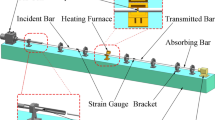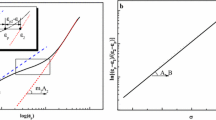Abstract
We focused on the modeling of the high-temperature Stress relaxation (SR) curves for Gr. 91 steel using two nonlinear models of a spring-dashpot and Peleg model to get a better fit to experimental relaxation data. A series of SR tests were performed under a constant strain of 0.6 % at 500, 550, 600 and 650 °C. The SR behavior of Gr. 91 steel was clarified based on the experimental data. In the modeling of the SR curves, each parameter value for the two models was optimized to give the best fit to the experiment SR data. The springdashpot model did not match the experimental data at 500 and 550 °C, although the model showed good agreement with the experimental data at 600 and 650 °C. However, the Peleg model was superior to the spring-dashpot model for all temperature conditions, and its parameter values followed temperature dependence well. Using the Peleg model, the SR curves for Gr. 91 steel could be suitably modeled at different temperature ranges. The confidence of the Peleg model was validated from elastic-creep finite element analysis. It is suggested that the Peleg model can be a useful tool to characterize the relaxation behavior of Gr. 91 steel.
Similar content being viewed by others
References
S. Spigarelli and E. Quadrini, Analysis of the creep behavior of modified P91 (9Cr-1Mo-NbV) welds, Mater. Des, 23 (2002) 547–552.
B. K. Choudhary and E. I. Samuel, Creep behavior of modified 9Cr-1Mo steel, J. Nucl. Mater, 412 (2011) 82–89.
W. G. Kim, J. Y. Park, I. M. W. Ekaputra, S. J. Kim and J. Jang, Influence of hold time and stress ratio on cyclic creep properties under controlled tension loading cycles of Grade 91 steel, Nucl. Eng. Tech., 49 (2017) 581–591.
W. G. Kim, J. Y. Park, S. J. Kim and J. Jang, Reliability assessment of creep rupture life for Gr. 91 steel, Mater. Des, 51 (2013) 1045–1051.
W. G. Kim, J. Y. Park, I. M. W. Ekaputra, S. J. Kim and J. Jang, Cyclic creep behavior under tension-tension loading cycles with hold time of modified 9Cr-1Mo steel, Mater. High Temp., 31 (2014) 249–257.
T. Shrestha, M. Basirat, I. Charit, G. P. Potirniche and K. K. Rink, Creep rupture behavior of Grade 91 steel, Mater. Sci. Eng. A, 565 (2013) 382–391.
I. M. W. Ekaputral, W. G. Kim, J. Y. Park, S. J. Kim and E. S. Kim, Characterization of the Q* parameter for evaluating creep crack growth rate for type 316LN stainless steel, J. of Mechanical Science and Technology, 30 (2016) 3151–3158.
H. Y. Lee, Comparison of elevated temperature design codes of ASME subsection NH and RCC-MRx, Nucl. Eng. Des., 308 (2016) 142–153.
W. G. Kim, J. Y. Park, B. K. Choudhary, S. J. Kim, M. H. Kim and J. Jang, Influence of data size on the reliability assessment of creep life of grade 91 steel, J. of Mechanical Science and Technology, 28 (2014) 4493–4501.
S. Holmstrom, R. Pohja, P. Auerkari, V. Friedmann, A. Klenk, B. Leibing, P. Buhl, M. Spindler and A. Riva, Long term stress relaxation modeling, ECCC Conference Creep & Fracture in High Temperature Component Design and Assessment, Rome, Italy (2014).
ASTM, Standard methods for stress relaxation tests for materials and structures, ASTM E328-13 (2013).
P. Felthan, Stress relaxation in copper and alpha-brasses at low temperatures, J. Inst. Metals, 89 (1961) 210–214.
J. D. Lubahn and R. P. Felgar, Plasticity and creep of metals, John Willy & Sons Inc, New York (1961) 363–404.
M. Peleg, Considerations of a general rheological model for the mechanical behavior of viscoelastic solid food materials, J. Text Stud, 2 (1976) 243–255.
R. Myhan, M. Markowski, T. Daszkiewicz, P. Zapotoczny and P. Sadowski, Non-linear stress relaxation model as a tool for evaluating the viscoelastic properties of meat products, J. of Food Engineering, 146 (2015) 107–115.
Author information
Authors and Affiliations
Corresponding author
Additional information
Woo-Gon Kim received his Ph.D. from Chungbuk National University in Mechanical Engineering in 1998. He is Principal Researcher at Korea Atomic Energy Research Institute. His specialty is mechanical assessment, analysis, modeling and database establishment of high temperature nuclear materials for Gen-IV reactor systems, and especially, time-dependent creep and crack growth behaviors at elevated temperature.
Recommended by Editor Chongdu Cho
Rights and permissions
About this article
Cite this article
Kim, WG., Park, JY., Won, MG. et al. Non-linear modeling of stress relaxation curves for Grade 91 steel. J Mech Sci Technol 32, 1143–1151 (2018). https://doi.org/10.1007/s12206-018-0217-6
Received:
Revised:
Accepted:
Published:
Issue Date:
DOI: https://doi.org/10.1007/s12206-018-0217-6




